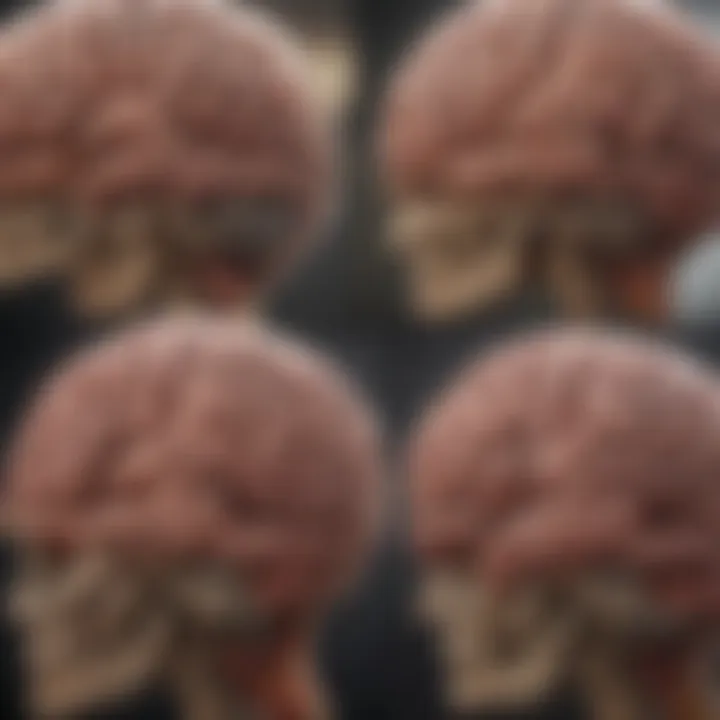Understanding Progressive Cognitive Decline: Mechanisms and Implications


Intro
Progressive cognitive decline is a pressing issue that affects countless individuals worldwide. It is a term that encompasses a range of cognitive impairments, from mild memory lapses to severe dementia. Understanding the trajectory of cognitive decline is essential, as it impacts not only the affected individuals but also their families and society at large. The exploration into this area requires a multifaceted approach, focusing on the various mechanisms behind cognitive deterioration, the associated risk factors, and the clinical implications for patients and practitioners alike.
As research in this domain expands, it becomes crucial to synthesize findings to shed light on how early interventions may be developed. This article serves as a comprehensive examination of progressive cognitive decline, offering detailed insights that can guide future practices and inform ongoing research.
Research Overview
Summary of Key Findings
Research indicates that cognitive decline is influenced by a myriad of factors. The studies reveal strong correlations between aging, genetic predispositions, and lifestyle choices. Notably, neurodegenerative diseases such as Alzheimer's and vascular dementia significantly contribute to cognitive impairments.
Key findings include:
- Age-related changes in brain structure and function can accelerate decline.
- Specific biomarkers, such as amyloid plaques and tau tangles, often signify early stages of cognitive impairment.
- Lifestyle factors, including diet, exercise, and social engagement, play a critical role in mitigating cognitive decline.
Importance of the Research
The importance of understanding progressive cognitive decline cannot be overstated. It not only prepares healthcare professionals for better patient management but also fosters awareness among the general public. This knowledge serves as a catalyst for early detection and intervention strategies, which may ultimately improve quality of life for individuals experiencing this decline. By exposing the intricate dynamics of cognitive degeneration, researchers and clinicians can work together to develop comprehensive care models that address both the medical and emotional needs of patients.
Methodology
Study Design
Researchers have employed various study designs to explore cognitive decline effectively. Longitudinal studies have been particularly beneficial, as they allow for observation over time, providing insights into how cognitive functions change. Cross-sectional studies, on the other hand, give a snapshot of cognitive abilities among different age groups, helping to identify trends and patterns.
Data Collection Techniques
Data collection for cognitive decline research often involves a combination of qualitative and quantitative methods. Common techniques include:
- Cognitive assessments: Standardized tests, such as the Mini-Mental State Examination (MMSE), assess various cognitive functions.
- Neuroimaging: MRI and CT scans are used to observe structural changes in the brain.
- Surveys and questionnaires: These instruments gather information regarding demographic data, health history, and lifestyle habits of participants.
Through these methods, researchers can draw significant conclusions that advance our understanding of cognitive decline and its implications.
"Understanding the multifactorial nature of cognitive decline is fundamental for developing effective interventions."
Engaging with this research presents an opportunity to not only inform patients and practitioners but also to contribute to the broader scientific community's ongoing discourse around cognitive health.
Defining Progressive Cognitive Decline
Defining progressive cognitive decline is crucial to understanding its complexities and broad implications. Cognitive decline refers to a gradual reduction in cognitive abilities, which can impact memory, attention, and reasoning. It is not a singular condition but a spectrum of symptoms associated with various neurological diseases such as Alzheimer’s and other forms of dementia. Recognizing the nuances within this term enables a more precise dialogue about its causes, risk factors, and consequences.
Understanding Cognitive Decline
Cognitive decline can manifest in numerous ways, but it primarily affects several functions: memory, problem-solving, language, and executive functions. It can arise from normal aging processes or indicate the onset of a more serious condition. Understanding cognitive decline entails a multidisciplinary approach, incorporating insights from geriatrics, neurology, and psychology. Researchers emphasize that cognitive decline is not merely a consequence of age; it can also be influenced by genetic factors, lifestyle choices, and environmental exposures. This perspective is essential, as it brings renewed attention to prevention and early intervention, which can play a significant role in managing cognitive health.
In the context of clinical practice, recognizing early signs of cognitive decline can facilitate timely interventions. For instance, subtle memory lapses or difficulty in concentrating could signal the beginning of a decline that warrants closer evaluation. Understanding these initial symptoms is vital for healthcare professionals, as intervention at this stage can potentially slow progression and improve quality of life.
Stages of Cognitive Decline
Cognitive decline typically progresses through several identifiable stages, each with distinct characteristics. The classification most referenced follows a continuum from mild cognitive impairment (MCI) to severe forms of dementia.
- Mild Cognitive Impairment (MCI):
- Moderate Cognitive Decline:
- Severe Cognitive Decline:
- Individuals may experience slight but noticeable changes in their cognitive functions.
- Memory issues become more apparent, yet they do not significantly interfere with daily activities.
- Cognitive functions continue to deteriorate, affecting daily life and independent functionality.
- Individuals may struggle with language and may find it difficult to follow conversations or manage tasks.
- The final stage often leads to profound cognitive losses, resulting in complete reliance on caregivers.
- Symptoms may include disorientation to time and place, significant memory loss, and difficulty recognizing loved ones.
The acknowledgment of these stages is imperative for developing effective interventions tailored to individual needs. By identifying the stage of cognitive decline, healthcare providers can strategize personalized care plans that address specific challenges faced by the individual.
Cognitive decline is a multifaceted issue that encompasses clinical, social, and personal dimensions. A thorough understanding of its definition and stages allows both medical professionals and caregivers to better support those affected.
Epidemiology of Cognitive Decline
The interplay between progressive cognitive decline and epidemiological factors underscores the public health significance of understanding this phenomenon. Studying the epidemiology of cognitive decline reveals critical insights into its prevalence, distribution, and impact across various populations. This section emphasizes how these factors can guide healthcare interventions, establish preventive measures, and shape research agendas. Recognizing the patterns of cognitive decline is essential for early intervention and personalized healthcare strategies. The understanding of epidemiological data also aids in mitigating stigma and facilitating the allocation of resources to affected individuals and their families.
Prevalence Rates
Prevalence rates provide a quantitative foundation for understanding how widespread cognitive decline is within a specified population. The figures vary significantly, influenced by factors such as age, geographical location, and socioeconomic status. Current estimates indicate that approximately 5 to 10 percent of individuals over the age of 65 experience some form of cognitive impairment. This rate dramatically increases with age; by age 85, the prevalence may reach over 40 percent.
Such statistics are critical in highlighting the need for targeted research and intervention strategies at the community and healthcare level. The rise in prevalence rates implies that as the population ages, healthcare systems must adjust to address the growing demand for cognitive health services.
"Alarming statistics reveal that worldwide, around 50 million individuals are living with dementia, and this number is projected to reach 82 million by 2030 and 152 million by 2050."


Addressing these findings from an epidemiological perspective enables a more robust understanding of cognitive decline dynamics. To summarize:
- Cognitive decline prevalence rises with age.
- Approximately 5-10% among those aged 65 and older.
- Over 40% by age 85.
- 50 million currently affected globally, projected to rise significantly.
Demographic Variations
Demographic factors significantly impact the progression and manifestation of cognitive decline. These factors range from age, gender, race, and social determinants of health. For instance, research shows that women are often more affected than men, potentially due to longevity as well as biological differences. Studies suggest that nearly two-thirds of individuals with Alzheimer’s disease are women.
Geographical variations also play a crucial role. Cognitive decline prevalence exhibits differences between countries and regions, influenced by genetics, lifestyle factors, and environmental conditions. For example, populations in regions with low educational attainment or limited access to healthcare show higher rates of cognitive impairment compared to those in more affluent areas.
Additionally, racial and ethnic disparities exist in the context of cognitive decline. African Americans and Hispanics are at a heightened risk for various forms of dementia compared to their White counterparts. These disparities underscore the importance of culturally competent care and targeted education surrounding cognitive health in different demographic groups.
Key considerations include:
- Higher prevalence of cognitive decline in women.
- Geographic disparity influences rates of cognitive impairment.
- Racial and ethnic groups experience varied risks, with African Americans and Hispanics facing higher risks.
Neuroscientific Mechanisms Behind Cognitive Decline
Understanding the neuroscientific mechanisms underlying cognitive decline is crucial. This section explores how changes in the brain structure and function contribute to the progressive loss of cognitive abilities. Grasping these mechanisms can not only enhance our understanding of cognitive decline but also inform strategies for diagnosis and intervention.
Neuroanatomical Changes
Neuroanatomical changes are profound in the context of cognitive decline. Studies show that specific brain regions undergo atrophy with age or disease progression. For instance, the hippocampus, essential for memory formation, frequently displays notable shrinkage in individuals with Alzheimer's disease. A direct correlation exists between the degree of atrophy in this area and the severity of memory impairment observed in patients.
Another area of concern is the cerebral cortex, particularly in frontal and temporal lobes, which are imperative for higher-order cognitive functions. Decreased volume in these regions is often associated with executive dysfunction and impaired language skills.
The loss of synaptic density also plays a significant role. As synapses, the connections between neurons, diminish, so does the brain's capacity to efficiently process and store information. This decline can lead to a cascade of cognitive deficits experienced by individuals as they age.
Neurotransmitter Dysfunction
Neurotransmitter dysfunction is another pivotal aspect in the decline of cognitive functions. Neurotransmitters are chemicals facilitating communication between neurons. The balance of these chemicals is crucial for maintaining cognitive health.
Dopamine, for example, is fundamentally involved in attention and reward processing. Reduced dopamine levels are notably linked to cognitive impairments in disorders like Parkinson's disease. Similarly, acetylcholine depletion is a hallmark of Alzheimer's, leading to significant cognitive decline, affecting memory and learning capabilities.
It is also pertinent to highlight that neurotransmitter systems do not operate in isolation but rather interact. For instance, an imbalance in serotonin levels can also affect dopamine functioning, further exacerbating cognitive decline. Thus, understanding the intricate interplay between these neurotransmitters is essential for approaching therapeutic interventions.
Inflammation and Cognitive Health
Inflammation plays a pivotal role in cognitive health and decline. Chronic neuroinflammation has emerged as a contributing factor to various neurodegenerative diseases. This state is often characterized by the activation of glial cells, which release pro-inflammatory cytokines. Such cytokines can hinder synaptic plasticity and neuronal integrity, critical for maintaining cognitive function.
The brain's immune response, when excessively activated, can lead to a cycle of damage. It is hypothesized that inflammation leads to amyloid plaque formation in Alzheimer's disease, further impairing neuronal function and communication.
Moreover, lifestyle factors such as dietary habits and physical activity can influence levels of systemic inflammation. Interventions aimed at reducing inflammation may present a proactive approach in the management of cognitive decline. Incorporating anti-inflammatory foods, like leafy greens and omega-3 fatty acids, could be beneficial.
The relationship between inflammation and cognitive decline underscores the complexity of brain health yet highlights potential pathways for intervention.
Risk Factors for Cognitive Decline
Understanding the risk factors for cognitive decline is crucial. It provides insight into how various elements contribute to the deterioration of cognitive abilities. Identifying these risk factors helps in developing preventive strategies and interventions, as well as managing the impact of cognitive decline on individuals and communities. Without understanding these elements, efforts to combat this decline may lack efficacy.
Genetic Predispositions
Genetics play a significant role in cognitive health. Certain inherited traits can increase the likelihood of developing conditions that lead to cognitive decline. For instance, the apolipoprotein E (ApoE) gene is linked to Alzheimer’s disease. Individuals with the ApoE4 variant face a higher risk of developing this debilitating condition.
Moreover, family history can be another indicator. If a relative has experienced significant cognitive decline, there may be an increased risk among other family members.
Yet, genetics alone do not determine fate. They interact with environmental and lifestyle factors, creating a complex web of influences. Awareness of genetic risks allows for informed choices. This knowledge can encourage proactive measures such as increased monitoring of cognitive health or early intervention strategies.
Lifestyle Influences
Lifestyle choices play an essential role in cognitive decline. Factors such as diet, exercise, and social engagement impact overall brain health. For example, a diet rich in antioxidants, like that found in berries and leafy greens, has been shown to potentially reduce oxidative stress in the brain.
Regular physical activity helps maintain blood flow to the brain, potentially improving cognitive function. Research suggests that even moderate exercise can aid in preserving memory and thinking skills. Furthermore, staying socially active supports mental well-being, reducing feelings of isolation and depression that may accompany cognitive decline.
Consistent habits can bestow protective benefits. To enable a healthier lifestyle, individuals can:
- Prioritize a balanced diet rich in nutrients.
- Engage in regular aerobic and strength-training exercises.
- Maintain relationships and social activities.
Chronic Health Conditions
Chronic health conditions significantly correlate with cognitive decline. Diseases such as diabetes, hypertension, and cardiovascular issues can influence brain health over time. For instance, research indicates that uncontrolled diabetes may lead to cognitive impairment as high glucose levels damage blood vessels, affecting the brain’s function.
Additionally, cardiovascular health is closely linked to cognitive status. A history of strokes or heart disease can increase the risk for dementia. Attention to managing these chronic conditions can greatly influence cognitive trajectory.
Effective management strategies include:


- Regular health screenings to monitor chronic conditions.
- Medication adherence to prevent complications.
- Lifestyle adjustments focused on overall health.
"Understanding risk factors is an essential step toward fostering cognitive resilience and enhancing life quality."
By recognizing these risk factors, individuals can take steps to mitigate their risk. This not only improves quality of life but also emphasizes the importance of preventive care and lifestyle management in the context of cognitive health.
Diagnosis of Cognitive Decline
The diagnosis of cognitive decline plays a crucial role in understanding the progression and management of various cognitive impairments. Early detection is essential as it can significantly influence outcomes for patients and their families. Identifying cognitive decline often leads to timely interventions and can mitigate further deterioration. It also helps to differentiate between normal aging and pathological conditions, which is important for both diagnosis and treatment.
Evaluating cognitive decline requires careful consideration of various factors including medical history, presenting symptoms, and family background. Healthcare professionals must utilize a multi-faceted approach to assess cognitive capabilities effectively, which underscores the importance of comprehensive assessments in the diagnostic process. This can help in recognizing patterns that may indicate underlying conditions, such as Alzheimer’s disease or other forms of dementia.
Clinical Assessments
Clinical assessments are primary tools used to evaluate cognitive decline. These evaluations typically involve a combination of interviews, observations, and standardized tests aimed at assessing various cognitive functions, such as memory, attention, and executive function.
The process often includes:
- Patient History: Gathering detailed medical history, including past illnesses, medications, and family history of cognitive disorders.
- Physical Examination: Conducting general health assessments to rule out other potential causes of cognitive symptoms, like thyroid disorders or vitamin deficiencies.
- Neurological Examination: Testing reflexes, coordination, and sensory functions to identify any neurological issues.
These clinical assessments also foster a collaborative relationship between patients and healthcare providers. Through this engagement, patients may feel more inclined to express their concerns, leading to more accurate diagnoses.
Neuropsychological Testing
Neuropsychological testing is an integral aspect of diagnosing cognitive decline. This form of assessment provides a deeper analysis of a person's cognitive abilities by utilizing specific tests designed to measure different cognitive domains. These typically include memory, attention span, problem-solving skills, and language abilities.
The key advantages of neuropsychological testing are:
- Detailed Evaluations: Provides nuanced insights into specific cognitive deficits.
- Objective Measurements: Establishes baselines for cognitive performance and changes over time.
- Diagnostic Aid: Assists in distinguishing between types of cognitive decline, such as identifying whether the decline is due to dementia or another underlying issue.
Neuropsychological tests can also support treatment planning and monitor progress over time. Effective management strategies can emerge from the outcomes of these tests, ensuring tailored interventions are established to address the individual needs of the patient.
In summary, accurate diagnosis of cognitive decline through comprehensive clinical assessments and neuropsychological testing is critical. These methods not only guide treatment but also enhance understanding of the cognitive challenges faced by individuals.
Impact of Cognitive Decline on Daily Life
Understanding the impact of progressive cognitive decline on daily life is crucial for comprehending its far-reaching consequences. Individuals experiencing cognitive decline face challenges that significantly affect their quality of life. This section examines how cognitive deterioration influences personal relationships and occupational functioning, shedding light on both emotional and practical implications.
Effects on Personal Relationships
Cognitive decline can severely strain personal relationships. As individuals struggle with memory, attention, and communication skills, interactions with family members and friends often change. Partners might feel frustration or sadness when their loved ones forget important dates or misplace objects. Parents may have difficulties connecting with their children, which alters family dynamics. In many cases, caregivers bear the brunt of this decline. They may experience stress and burnout due to the demands of caregiving, which leads to changes in the relationship with the individual affected by cognitive decline.
Specific ways cognitive decline affects personal relationships include:
- Difficulty in Communication: Affected individuals may struggle to find the right words, leading to misunderstandings or avoidance of conversations.
- Loss of Shared Activities: Hobbies or activities once enjoyed together may become challenging or unenjoyable, causing feelings of isolation.
- Emotional Distress: Family members and friends may feel grief, anger, or confusion, creating emotional distance.
Overall, cognitive decline undermines the foundations of personal relationships, prompting the need for education and support for both affected individuals and their loved ones.
Alterations in Occupational Functioning
Cognitive decline also yields significant changes in occupational functioning. Work engagement requires a range of cognitive abilities. When these skills decline, the ability to perform tasks effectively diminishes. This transition can lead to job loss or reduced job satisfaction.
The alterations in occupational functioning can manifest in several ways:
- Decreased Productivity: Individuals might find it challenging to complete tasks on time or maintain the quality of work expected.
- Increased Mistakes: Cognitive errors may become more frequent, leading to conflicts with coworkers or supervisors.
- Workplace Adaptation: Some workplaces might need to adjust job roles or provide additional support, which can be burdensome.
Such changes can result in profound implications, both economically and socially. Individuals facing cognitive decline may require retraining or even transition to different roles. Here, support systems in the workplace become essential, whether through training programs or mental health resources.
"The implications of cognitive decline extend beyond the individual, affecting relationships, work dynamics, and overall societal structures."
Interventions and Management Strategies
The section on interventions and management strategies is crucial in understanding how to address progressive cognitive decline. Various approaches might be employed to combat the deterioration of cognitive function. These strategies can offer individuals and caregivers tools not only to address the existing symptoms but potentially to slow the progression of decline. They are multifaceted and might involve pharmacological treatments, cognitive rehabilitation, and lifestyle changes. Each aspect brings a unique set of benefits and considerations, creating a comprehensive framework to enhance cognitive health.
Pharmacological Approaches
Pharmacological interventions form a significant part of managing cognitive decline. Several drugs target neurotransmitter systems to enhance cognitive functions or address underlying conditions contributing to decline. Medications such as Donepezil and Rivastigmine are commonly prescribed to patients with Alzheimer's disease. These drugs increase the levels of acetylcholine, a neurotransmitter associated with memory and learning.
- Mechanism of Action: These medications inhibit the breakdown of acetylcholine, allowing for better communication between neurons.
- Clinical Evidence: Studies indicate that these drugs can improve cognitive functions in some individuals. However, they do not reverse the progression of the disease, and their effectiveness varies among patients.
- Side Effects: Attention must be given to potential side effects, which can include gastrointestinal issues, sleep disturbances, and muscle cramps. Therefore, prescribers must weigh the benefits against possible adverse effects.
Cognitive Rehabilitation Techniques
Cognitive rehabilitation encompasses therapeutic approaches designed to improve functioning in daily life. This method aims to help individuals maximize their preserved cognitive abilities and compensate for the aspects that are declining.
- Targeted Exercises: These might include memory training, problem-solving tasks, and strategy development to manage cognitive deficits.
- Personalized Plans: Different individuals may need tailored interventions based on their specific cognitive profiles. Tailoring exercises to their preferences and needs enhances engagement and effectiveness.
- Evidence-Based Outcomes: Research indicates that individuals participating in cognitive rehabilitation can experience improvements in memory, attention, and overall quality of life. Regular assessment is important to adjust strategies as needed.


Lifestyle Modifications
Lifestyle changes can have a profound impact on cognitive health. Adopting a healthier lifestyle can potentially slow cognitive decline and improve overall well-being.
- Diet: A diet rich in fruits, vegetables, whole grains, and omega-3 fatty acids is associated with better cognitive function. The Mediterranean diet, in particular, has gained attention for its potential protective effects against cognitive decline.
- Physical Activity: Regular exercise, even low-impact activities like walking, significantly contributes to brain health. This activity encourages better blood flow and can enhance neurogenesis, the process of creating new neurons.
- Social Engagement: Maintaining social interactions may also protect against cognitive decline. Activities that involve socializing and mental engagement can keep cognitive functions active.
Research emphasizes that a holistic approach combining medication, cognitive rehabilitation, and lifestyle changes can lead to more promising outcomes in managing progressive cognitive decline.
In summary, the intervention strategies discussed here can provide a comprehensive plan for addressing progressive cognitive decline. From pharmacological options to lifestyle changes, each component plays a crucial role in enhancing cognitive health, improving daily functioning, and offering support for individuals and families affected by this challenging condition.
The Role of Technology in Cognitive Health
The integration of technology into cognitive health represents a significant advancement in our understanding and management of progressive cognitive decline. In this context, technology serves as both a tool for monitoring cognitive status and a platform for cognitive training. The relevance of technological applications cannot be overstated; they provide new avenues for early detection, intervention, and ongoing support for individuals experiencing cognitive challenges.
The impact of technology on cognitive health is multifaceted. Digital tools have emerged that allow for continuous monitoring of cognitive functions, offering insights that can aid in clinical assessments. Simultaneously, cognitive training applications leverage modern techniques and scientific research to enhance mental abilities. These elements contribute not only to managing current conditions but also to preventing further decline.
Digital Tools for Monitoring
Digital tools for monitoring cognitive health have become crucial in the assessment and management of conditions associated with cognitive decline. These tools often utilize mobile and web applications to collect data on various cognitive functions, such as memory, attention, and problem-solving abilities. One such tool might include online platforms that offer cognitive assessments through simple tasks and quizzes.
Using these digital tools can provide a more accurate picture of an individual's cognitive health over time.
- Benefits of Digital Monitoring:
- Facilitates regular tracking of cognitive abilities
- Provides data that can inform treatment plans
- Promotes early detection of cognitive decline
- Increases patient engagement in their cognitive health
While the benefits are clear, there are considerations that should not be overlooked. Not all individuals may feel comfortable using digital technology, and the data privacy and security of these platforms must be prioritized. Ensuring these tools are user-friendly is vital to maximize their effectiveness and accessibility.
Applications in Cognitive Training
Applications in cognitive training are designed to enhance cognitive abilities through targeted exercises and interventions. These tools utilize game-like environments and tasks that can stimulate various cognitive functions. For instance, applications like Lumosity or Elevate offer a variety of games that target memory, attention, speed of processing, and problem-solving skills.
- Key Features of Cognitive Training Apps:
- Personalization of training regimens based on user needs
- Adaptive difficulty levels to match user improvement
- Achievement tracking to motivate users
Such tools have gained attention in both clinical and non-clinical settings. Research indicates that engaging in regular cognitive training can slow the progression of cognitive decline and improve overall cognitive functioning. However, it is important to approach these applications with a critical mindset. The effectiveness of such training programs varies, and results can differ based on individual circumstances.
Research Frontiers in Cognitive Decline
The study of progressive cognitive decline is a critical area of exploration within both neurology and gerontology, generating ongoing research that seeks to clarify mechanisms underlying cognitive deterioration. Understanding this topic allows researchers and professionals to respond better to the challenges posed by cognitive decline. It is essential for developing new interventions and improving patient outcomes. This section will present two vital components of this area: innovative therapeutic approaches and preventative strategies under investigation.
Innovative Therapeutic Approaches
Innovative therapeutic approaches are reshaping the landscape of cognitive decline treatment. Many researchers are investigating various methods to enhance brain function and slow the decline. These can range from pharmacological advancements to non-pharmacological interventions.
- Pharmacological Innovations: Here, new drug therapies are being developed that target neurotransmitter systems associated with cognitive functions. For instance, agents aimed at modulating glutamate levels or enhancing cholinergic activity are being tested. They aim at providing neuroprotection to vulnerable brain regions.
- Neuromodulation Techniques: Another notable method includes transcranial magnetic stimulation (TMS) and deep brain stimulation (DBS). These techniques have shown potential in altering neural circuits and improving cognitive functions significantly.
- Combination Therapies: There is also a growing interest in combining pharmacological treatments with cognitive training or lifestyle interventions. Studies have shown that this integrative approach may produce more robust outcomes.
Innovative approaches are crucial for addressing cognitive decline effectively and opening up new avenues for research and therapy development.
Preventative Strategies under Investigation
Preventative strategies form another key focus in research concerning cognitive decline. These strategies aim to mitigate risk factors before cognitive deterioration becomes manifest. Addressing lifestyle choices, environmental influences, and even genetic predispositions holds considerable promise for reducing individual risk.
- Lifestyle Modifications: A healthy diet, regular exercise, and mental engagement have been identified as crucial elements in delaying the onset of cognitive decline. These lifestyle factors work synergistically to enhance neuroplasticity, which is vital for maintaining cognitive health.
- Public Health Interventions: Strategies at the community level, such as education about cognitive health and screening programs, are being studied for their effectiveness in early intervention.
- Genetic Research: Genetic research also offers insights into preemptive strategies. Specific gene variants are associated with higher risks for cognitive decline, and understanding these can guide screening practices.
Researching these preventative strategies is essential. Identifying how to disrupt cognitive decline before it manifests can change the trajectory of many lives.
Future Directions in Cognitive Health Research
Future directions in cognitive health research are essential for comprehending and addressing progressive cognitive decline effectively. As the global population ages, the burden of cognitive decline increases significantly. This necessitates a streamlined approach to research that encompasses both innovative therapeutic strategies and a broader understanding of health conditions related to cognitive functioning.
One pivotal element in future research is translational research opportunities. This involves moving findings from basic science into clinical practice. Through this process, researchers can develop interventions that demonstrate efficacy in real-world settings. It connects laboratory discoveries with patient care, ensuring that therapies are not just theoretically sound but also practically applicable. By translating research into actionable medical protocols, there is a chance to improve outcomes for individuals facing cognitive decline. A key consideration here is robustness in clinical trials and studies that can validate the effectiveness of new therapies
Translational Research Opportunities
Translational research is the bridge that carries scientific insights into clinical realities. The advancement in understanding the biological mechanisms of cognitive decline allows for more targeted interventions.
From genetic studies to behavioral therapies, various approaches are under evaluation. For instance, the potential of stem cell therapy to regenerate neuronal function is a promising area. Additionally,
- Biomarker identification helps in early diagnosis and tracking of cognitive decline.
- Medication-based interventions, such as those targeting neurotransmitter imbalances, show targeted benefits.
- Lifestyle interventions, harnessing diet and exercise, could lead to practical recommendations to mitigate risks.
Through these efforts, achieving tangible improvements in patient care becomes a distinct possibility.
Global Health Perspectives
Examining cognitive decline from a global health perspective brings insights into how cultural, social, and economic factors affect cognitive health. This section emphasizes the need for inclusive research that represents diverse populations.
As cognitive decline is not uniform, understanding how it manifests in different countries and communities is pivotal. There are several aspects to consider:
- Healthcare access and resources vary across regions, influencing the quality of care for cognitive decline.
- Cultural interpretations of cognitive health can impact willingness to seek help.
- Economic disparities directly affect the availability of interventions and support systems.
By focusing on these factors, researchers and practitioners can design effective strategies and policies that address the unique needs of various populations. Such understanding lays the groundwork for developing globally applicable interventions and ensures equitable cognitive health support.



